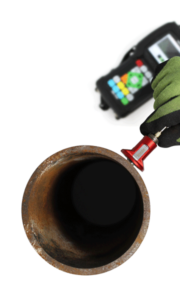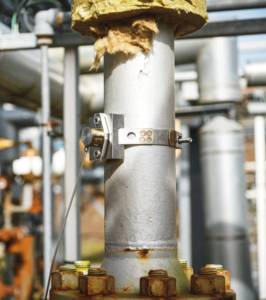If you squeeze piezoelectric materials, they generate current. If you apply voltage to them, they generate movement. Simple enough, but put a material like that inside a sensor device, and it can be all kinds of useful. Piezoelectric materials are the heart of ultrasonics, including submarine sonar, medical ultrasound, and even your car’s parking sensors.
However piezoelectric material can also run into limitations when it comes to temperature, radiation, or pressure levels.
Enter Tim Stevenson, previously a PhD student at the University of Leeds specialising in high-temperature piezoelectric metrology and extreme environment sensors. His team’s research led to the development of a new piezoelectric material “HPZ”, that works in hotter, colder, and more radioactive environments.
Realising the commercial potential of his work, Stevenson spun his research off to co-found Ionix Advanced Technologies.
“We first had to productionise the material, going from the lab into the real world,” says Stevenson, who is now the Chief Executive Officer of Ionix Advanced Technologies. “We quickly found we needed people to help integrate that material into the sensor platforms rather than simply supplying the material. Now, this is what Ionix does. We enable real-time measurement and data collection with our sensor technology. It empowers people to make decisions about assets and processes on-stream, without having to shut equipment down, or put it in isolation.”
This is a capability that is ever-more necessary as demand grows for IoT and Industry 4.0 tools. Ionix Advanced Technologies enables those tools to operate and take measurements in environments that were previously inaccessible.
“We are a sensor company, but the core of our business is this unique material,” Stevenson emphasises.
 School’s Out
School’s Out
It is one thing to develop a new product in an academic or research environment. It is quite another to turn that into a commercially viable product, much less a profitable business.
“There are always challenges in taking technology from university research and spinning it off into a business,” Stevenson says. “On top of that, everyone will tell you that advanced materials are the most challenging way of doing that.”
But, while the transition from researcher to business founder was an ambitious route to plot, Stevenson and the team also built a strong foundation to work from.
“We looked to use experienced people, and we initially hired a CEO to navigate some of those commercial challenges,” Stevenson recalls. “Once we got into actually making the sensors, we saw more and more diverse applications open up. Finding ways to do the necessary integration for those applications was an early roadblock we had to overcome to allow people to use our product.”
Finding people who have the technical expertise needed to create those sensors is one of Ionix’s biggest challenges, if not the biggest challenge facing the industry at large.
“We have a diverse range of people that we have brought together to solve complex problems,” Stevenson says. “Materials scientists and electrical engineers, all working to solve this one sensor problem. But what makes it work is the great mix of skills and backgrounds we have put together. It means we generate innovation faster, & can then move fast to get those products out.”
The next task is to train and invest in those staff. Even training can be a challenge when you are doing work based on innovation, however.
“We make sure people are trained on the job, but we often develop our own procedures where there is no existing training. We look to use peer recognised schemes, leveraging existing frameworks to set out a curriculum.”
It is work that has paid off, with most of Ionix’s staff having stayed with the company for eight years or more, and many of its people having been with the company from the start.
 Sensing Talent
Sensing Talent
Ionix started by putting the work into creating the material, and quickly learning and perfecting how to bond it with further materials technology, how to connect wires to it, and ultimately, how to create the full sensor package.
“We had to learn how to do those things, and that’s what led to HotSense, our core platform technology we use for all our sensors,” says Stevenson. “You are not just buying a piece of material from us, you are buying a fully integrated sensor.”
The platform Ionix Advanced Technologies has built is perfectly positioned to suit all the industrial sensor needs of OEMs across a wide selection of industrials, with still untapped potential remaining in the automotive, aviation, and a host of other industries.
“Process control is a big market,” Stevenson points out. “We do a lot of work in and around asset integrity, corrosion monitoring, but also industrial flow and level sensing. We see a lot of potential in the oil and gas sector, and any sector that uses flow metering for liquids or gases. Steam flow metering is quite exciting because steam is used anywhere that people need to move heat from one place to another. You will find it everywhere from refineries to hospitals.”
Mining is another area that Stevenson shows particular interest in, and Ionix is currently working on developing wear monitoring solutions for this sector, evaluating other harsh environments with big prospective applications. Sub-sea operations are also an area with a lot of potential.
“There are lots of good fits for our technology,” Stevenson says. “What we offer is a very robust material that can withstand extreme environments. In a sub-sea environment, sensors are exposed to high pressure and are often not handled that carefully. We offer end-to-end, next generation sensor-tech, based on a proprietary material. We can use that to make real-time measurements on process information while technology is on-stream, anywhere, at any time. We are the only ones who can do that.”
One test for the company is that while Ionix has groundbreaking technology, it is operating in a sector where it can be difficult to get the word out.
“We will make a transducer and sell it to someone else who integrates it into their system, but they are not necessarily going to tell people that we made their transducer,” Stevenson points out. “Meanwhile, from our end, there is no big database of companies using piezoelectric parts, so finding customers was a challenge. We did not know who was using that technology and people didn’t know we existed.”
For Ionix Advanced Technologies the Covid pandemic presented new opportunities as the big integration projects slowed down and demand for consumable sensors around facilities such as power stations increased.
“We brought our brand to the front,” Stevenson says. “People saw those products working in the marketplace, unlocking a lot of new opportunities for us.”
Looking forward, Stevenson has plans to move Ionix down the value chain of materials, providing a full sensor driven data solution, and beyond.
“We are exploring other properties of our materials, including lead-free alternatives, as well as other extreme environments we can focus on,” Stevenson says. “There is so much more we can do.”








